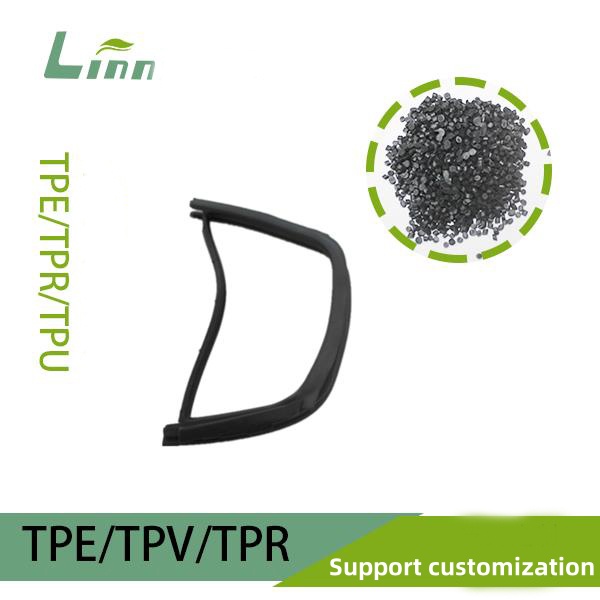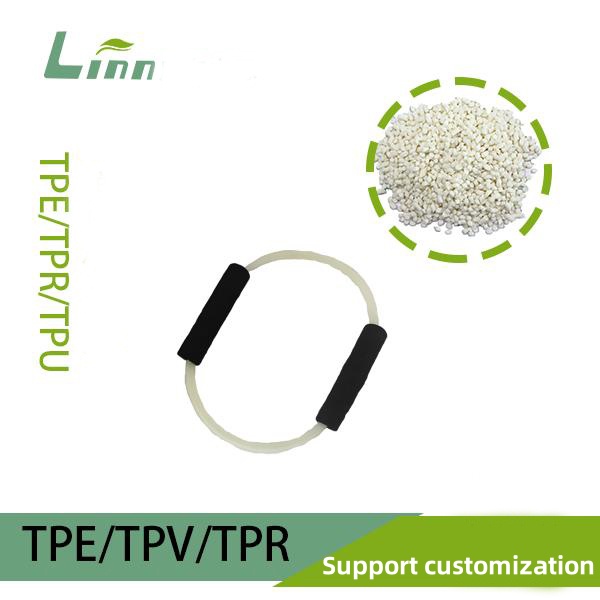Hey everyone! I’m a materials engineer at Linn, where I’ve been knee-deep in thermoplastic elastomers (TPE) for over 15 years. If you’re here, I’m guessing you’ve run into a pesky issue: your TPE injection-molded parts are coming out with white marks or discoloration around the sprue—the spot where the material flows into the mold. It’s frustrating, right? I’ve seen this plenty of times in my career, both in our production runs and from folks reaching out for advice. Today, I’m going to break down why this whitening happens, what’s going on inside the material, and—most importantly—how to fix it. Let’s get into it!
What’s Happening When the Sprue Turns White?
First off, let’s picture it: you pop a TPE part out of the mold, and there it is—a chalky, whitish patch right where the sprue meets the part. Sometimes it’s faint, sometimes it’s glaring, but either way, it’s not what you signed up for. As someone who’s spent years tweaking TPE processes at Linn, I can tell you this isn’t uncommon in injection molding, especially with elastomers like TPE.
So, what’s the deal? From my experience, this whitening—often called “stress whitening” or “blushing”—is tied to how TPE behaves under pressure, heat, and flow. It’s not just a surface flaw; it’s a clue about what’s happening during molding. Let’s dig into the reasons behind it.

The Causes: Why Does the Sprue Whiten?
TPE’s a blend of styrene-based elastomers (like SEBS or SBS), plasticizing oils, and additives, giving it that stretchy, rubbery vibe. But during injection molding, a lot can go wrong at the sprue—the narrow gateway where molten TPE rushes in. Here’s what I’ve pinpointed as the main culprits, based on years of troubleshooting:
1. Excessive Shear Stress
When TPE flows through the sprue, it’s under intense pressure and speed. If the sprue’s too small or the injection’s too fast, the material gets sheared—think of it like stretching dough too thin. This messes with the polymer chains, causing micro-tears or crazing that scatter light and turn the area white. I’ve seen this a ton with high-viscosity TPE grades pushed through tight gates.
One time, I was inspecting a mold run at Linn, and the sprue area looked like it’d been frosted. A quick check showed the injection speed was cranked too high—dialing it back cleared it up.
2. Temperature Imbalance
TPE molding happens at 180°C to 220°C, but if the melt’s too hot or the mold’s too cold, trouble brews. Overheating can degrade the material, while a chilly mold causes rapid cooling at the sprue, locking in stress and whitening. I’ve caught this in action—parts from a mold at 15°C had white sprues, but bumping it to 25°C smoothed things out.
3. Material Degradation
If TPE sits in the barrel too long or gets recycled too many times, it can break down. The oils evaporate, the polymers weaken, and you get a brittle, whitish sprue. I’ve tested degraded TPE samples under a microscope—tiny voids form, scattering light and giving that chalky look.

4. Mold Design Flaws
A poorly designed sprue—too sharp, too narrow, or misaligned—can choke the flow, ramping up stress. I’ve seen molds with abrupt transitions from sprue to runner that practically guaranteed whitening. Smooth, tapered designs make a world of difference.
5. Release Agent Overuse
Sometimes, mold release sprays leave a residue that reacts with TPE at the sprue, causing a white film. I had a client swear their parts were defective until we traced it to a sticky silicone spray they’d over-applied.
What Does Whitening Look Like? A Quick Breakdown
Not all whitening is the same—it varies by cause. Here’s a table I’ve whipped up from my observations to help you figure out what’s up:
| Whitening Type | Appearance | Likely Cause | Common Parts |
|---|---|---|---|
| Chalky Patch | Dull, white haze | High shear stress | Thin-walled grips, seals |
| Frosted Streaks | Linear, milky streaks | Temperature mismatch | Long runners, tubes |
| Brittle White | Crumbly, cracked white | Material degradation | Recycled TPE parts |
| Cloudy Film | Thin, glossy white layer | Excess mold release | High-gloss cases, handles |
This should clue you in. Chalky? Probably stress. Frosted? Check your temps.
Is Sprue Whitening a Problem?
Here’s the reassuring part: whitening at the sprue is usually cosmetic, not functional. The part itself—say, a seal or grip—still works fine. I’ve tested plenty of whitened samples at Linn; strength and elasticity hold up unless the material’s truly degraded. But if you’re making something visible or selling it, those marks can be a dealbreaker. Plus, heavy whitening might hint at bigger process issues worth fixing.
How to Fix Whitening at the Sprue
Alright, let’s tackle it! Over the years, I’ve dialed in some solid ways to reduce or eliminate this whitening, both during production and after the fact. Here’s what I’ve found works:
1. Adjust Injection Speed and Pressure
Slow down the injection speed and lower the pressure a bit. Less shear means less stress. I’ve done this on a tricky TPE seal mold—dropped the speed by 20%, and the sprue went from white to clear in one run.

2. Optimize Temperatures
Balance the melt and mold temps:
Keep the melt at the lower end (180°C-200°C) to avoid burning.
Warm the mold slightly (20°C-30°C) to ease cooling stress.
I tweaked a mold temp from 10°C to 25°C once, and the whitening vanished like magic.
3. Redesign the Sprue
If you can, widen or taper the sprue for smoother flow. I’ve worked with mold designers to add a 1-2° draft angle—stress dropped, and so did the white marks.
4. Check Material Quality
Use fresh, high-quality TPE—avoid over-recycled stuff. At Linn, we run tests on every batch with a melt flow indexer to catch degradation early. I’ve swapped out a funky recycled blend for virgin TPE, and the sprue issues stopped cold.

5. Cut Back on Release Agents
Use minimal mold release—or skip it if the mold’s polished. I’ve switched to dry-running molds on some runs, and the sprue stayed clean.
6. Post-Processing (If Needed)
For finished parts, lightly buff the sprue with a soft cloth or fine sandpaper (like 1000-grit). I’ve done this on sample grips—it hides the whitening without hurting the part.
Preventing Whitening: Lessons from the Field
Fixing it is great, but keeping it from happening? That’s the goal. Here’s what I’ve learned:
Fine-Tune Settings: Start with lower speeds and pressures, then adjust up as needed.
Monitor Temps: Keep melt and mold in sync—check with a thermometer if you can.
Design Smart: Work with your mold maker for smooth sprue transitions.
Quality First: Stick to reliable TPE—like Linn’s—that’s less prone to breakdown.
I’ve seen this pay off. A client’s TPE parts went from 30% whitening to zero after we optimized their mold and settings together.

From the Factory: How Linn Keeps Sprues Clean
Since I’m at Linn, I’ll share how we tackle this in-house:
Process Control: We calibrate injection speeds and temps for each TPE grade.
Mold Precision: Our tools have tapered sprues and polished surfaces.
Material Checks: We test every lot for consistency—no degraded stuff makes the cut.
I recall a batch of TPE handles—first run had white sprues. We slowed the injection, warmed the mold, and the next batch was spotless. It’s all about dialing it in.
Wrapping Up: Whitening Doesn’t Have to Stick
There you have it—why TPE sprues whiten and how to handle it. Whether it’s tweaking your machine, redesigning the mold, or just buffing it out, you’ve got options. As a materials guy, I’d say don’t let it stress you—most of it’s fixable with a little know-how. And if you’re using TPE from a solid source like Linn, you’re already ahead of the game.
Got questions? Hit me up below—I’m here to help!

FAQ Section
Q1: Can I totally stop sprue whitening?
A: Pretty much—optimize speed, temp, and mold design, and it’s rare. Some TPE grades are trickier, but tweaks get you close.
Q2: How long does it take to fix whitening?
A: Process tweaks? A few test runs—maybe an hour. Buffing a part? Five minutes tops.
Q3: Does whitening mean bad TPE?
A: Not always—just stress or heat issues usually. If it’s brittle too, then check material quality.
Q4: Why don’t some parts whiten?
A: Better molds and settings. Linn’s TPE, for instance, runs smoothly with dialed-in processes.


